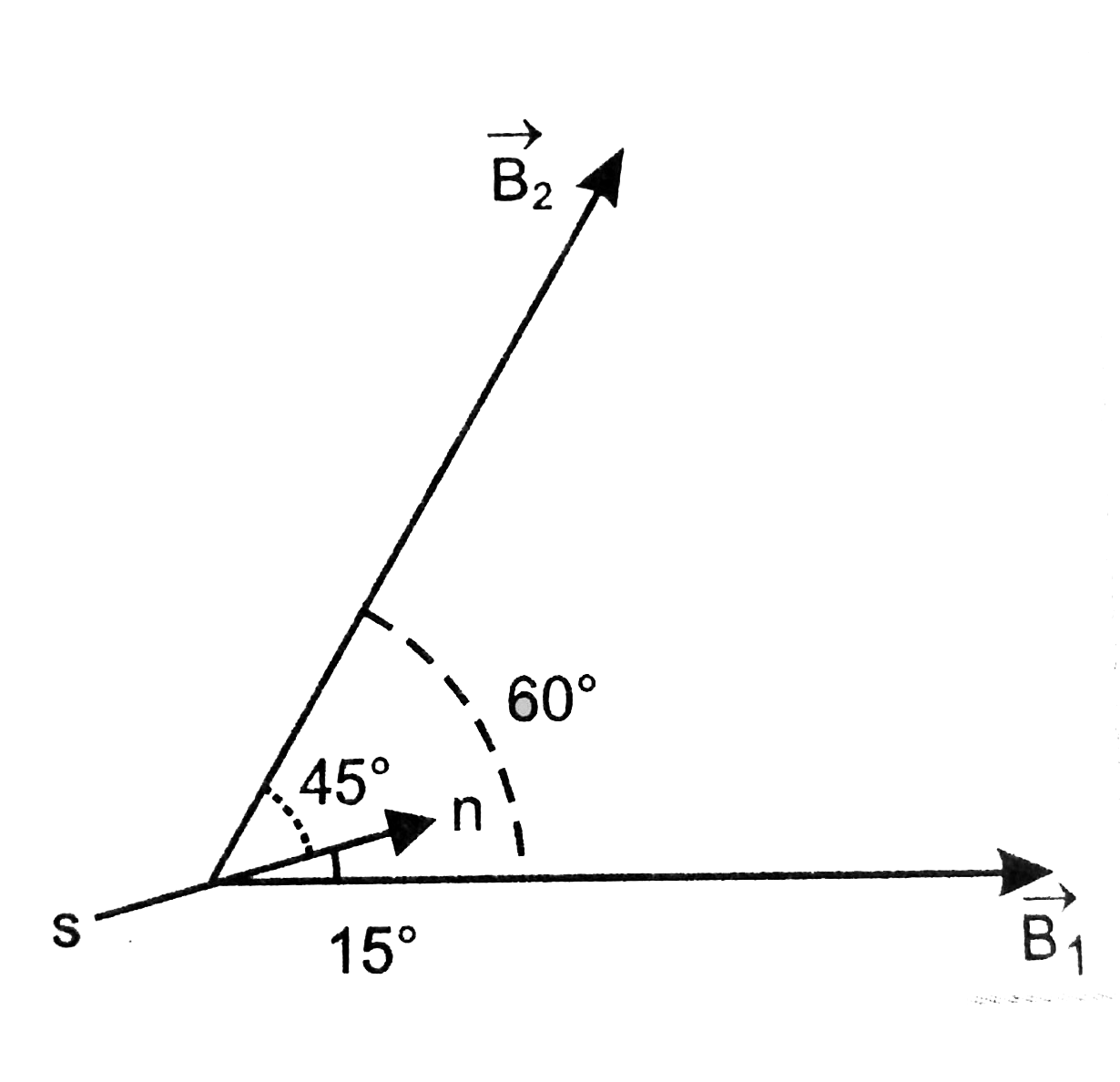A magnetic dipole is under the influence of two orthogonal magnetic fields, B1=0.5×10−3TandB2=0.866×10−3T. If the dipole comes to stable equilibrium at an angle θ with respect to B2 field, then the value of θ isSolution in Telugu
45∘
30∘
60∘
90∘
The correct Answer is:B
From tangent law, we have,
mB2sinθ=mB1sin(90∘−θ)

⇒tanθ=B1B2=0.5×10−30.866×10−3
=12√32=1√3
tanθ=tan30∘
⇒θ=30∘
Topper's Solved these Questions
- AP EAMCET SOLVED PAPER 2019 (22-04-2019, SHIFT-2)Book:TS EAMCET PREVIOUS YEAR PAPERSChapter:AP EAMCET SOLVED PAPER 2019 (22-04-2019, SHIFT-2)Exercise:PHYSICS
Explore 40 Videos
- ONLINE QUESTION PAPER 2018Book:TS EAMCET PREVIOUS YEAR PAPERSChapter:ONLINE QUESTION PAPER 2018Exercise:PHYSICS
Explore 160 Videos
Similar Questions
If A represents density, B represents velocity, C represents specific heat capacity and D represents wavelength, then the quantity having the dimensions of product of A, B, C and D is
View SolutionMatch the entries in List I with those in List II.

View SolutionA magnetic dipole is under the influence of two magnetic fields. The angle between the field direction is 60^(@) and one of the fields has magnitude of 1.2 xx 10^(-2)T . If the dipole comes to stable equilibrium at an angle of 30^(@) with this Held, then the magnitude of the field is
View SolutionA magnetic dipole is under the influence of two magnetic fields. The angle between the field directions is 60∘, and one of the fields has a magnitude of 1.2×10−2T. If the dipole comes to stable equilibrium at an angle of 15∘ with this field, what is the magnitude of the other field ?
View SolutionA magnetic dipole is under the influence of two magnetic fields. The angle between the field directions is 60∘ and one of the fields has a magnitude of 1⋅2×10−2 tesla. If the dipole comes to stable equilibrium at an angle of 15∘ with this field, figure, what is the magnitude of the other field?

View SolutionA magnetic dipole is under the influence of two magnetic fields. The angle between the field directions is 60^@ , and one of the fields has a magnitude of 1.2 xx 10^(-2) T. If the dipole comes to stable equilibrium at an angle of 15^@ with this field, what is the magnitude of the other field?
View SolutionA magnetic dipole is under the influence of two magnetic fields. The angle between the field directions is 60^@ , and one of the fields has a magnitude of 1.2 xx 10^(-2) T. If the dipole comes to stable equilibrium at an angle of 15^@ with this field, what is the magnitude of the other field ?
View SolutionA magnetic dipole is under the influence of two magnetic fields. The angle between the field directions is 60°, and one of the fields has a magnitude of 1.2×10−2T. If the dipole comes to stable equilibrium at an angle of 15° with this field, what is the magnitude of the other field?
View SolutionA magnetic dipole is under the influence of two magnetic fields. The angle between the field direction is 60^(@) and one of the fields has magnitude of 1.2 xx 10^(-2)T . If the dipole comes to stable equilibrium at an angle of 30^(@) with this Held, then the magnitude of the field is
View SolutionA magnetic dipole is under the influence of two magnetic fields. The angle between the field direction is 60° and one of the fields has a magnitude of 1.2×10−2T. If the dipole comes to stable equilibrium at an angle of 15∘ with this field, what is the magnitude of the other field?
View SolutionMagnetic field in an electromagnetic field B_(y) = 2 xx 10 ^(-7) sin (0.5 xx 10 ^(3) x + 1.5 xx 10 ^(11) t ) t It is transmitted in the sky. The frequency of an electromagnetic wave is
View SolutionMagnetic field in an electromagnetic field B_(y) = 2 xx 10 ^(-7) sin (0.5 xx 10 ^(3) x + 1.5 xx 10 ^(11) t ) t It is transmitted in the sky. The intensity of the electromagnetic field will be
View SolutionMagnetic field in an electromagnetic field B_(y) = 2 xx 10 ^(-7) sin (0.5 xx 10 ^(3) x + 1.5 xx 10 ^(11) t ) t It is transmitted in the sky. The maximum value of the electric field is
View SolutionMagnetic field in an electromagnetic field B_(y) = 2 xx 10 ^(-7) sin (0.5 xx 10 ^(3) x + 1.5 xx 10 ^(11) t ) t It is transmitted in the sky. What will be the wavelength of this electromagnetic wave?
View SolutionA magnetic dipole is under the influence of two magnetic fields. The angle between the field directions is 60∘ and one of the fields has a magnitude of 1.2×10−1T. If the dipole comes to stable equilibrium at an angle of 30∘ with this field, then the magnitude of the field (in tesla) is x×102T. Find x,
View Solution

